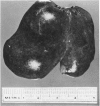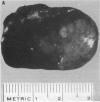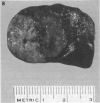Abstract
Male and female Sprague-Dawley rats (70 males and 70 females in the initial group) were fed a diet containing a polychlorinated biphenyl mixture (Aroclor 1260, 100 ppm for 16 months and 50 ppm for an additional 8 months) for 2 years followed by a control diet for 5 months. A control group initially consisted of 63 males and 63 females. Sequential morphologic changes were evaluated throughout the study. In the PCB-exposed group the following hepatocellular lesions developed in sequence: centrolobular cell hypertrophy at 1 month, foci of cell alteration at 3 months, areas at 6 months, neoplastic nodules at 12 months, trabecular carcinoma at 15 months, and adenocarcinoma at 24 months. In addition, simple and cystic cholangioma at 18 and 23 months, respectively, and adenofibrosis at 22 months were present. With the exception of hepatocyte hypertrophy and adenofibrosis, all lesions contained cells that were positive for gamma glutamyl transpeptidase activity. In the PCB-exposed group that was examined after 18 months, hepatocellular neoplasms were present in 95% of the 47 females and in 15% of the 46 males. Distant organ metastases did not occur and the mortality rate was not increased in the PCB exposed group. In 81 control rats examined after the 18th month, only 1 hepatocellular neoplasm (a neoplastic nodule) occurred. PCB- exposed and control rats developed simple cholangioma, cystic cholangioma and adenofibrosis; the incidence of each was greater in the PCB group. Thus, within the Sprague-Dawley rat group exposed to a diet with relatively high concentrations of Aroclor 1260 for 2 years a hepatocarcinogenic effect manifested by formation of slowly growing hepatocellular carcinomas was produced.
Full text
PDF
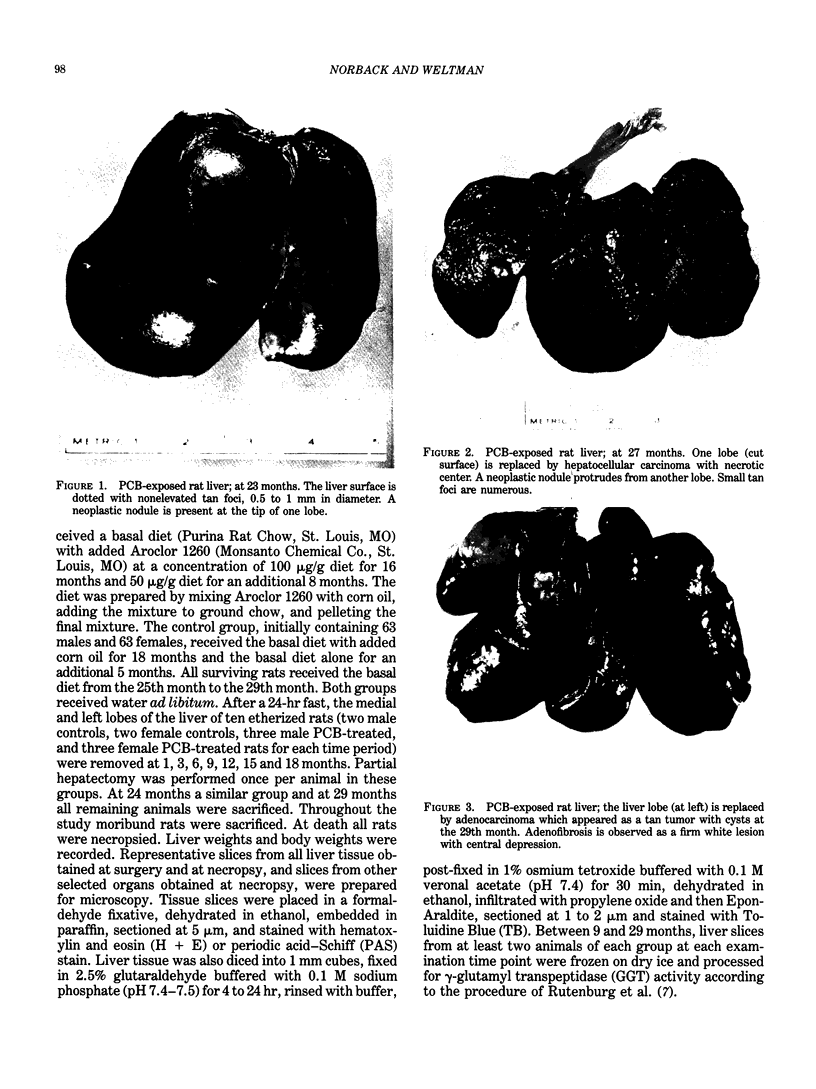



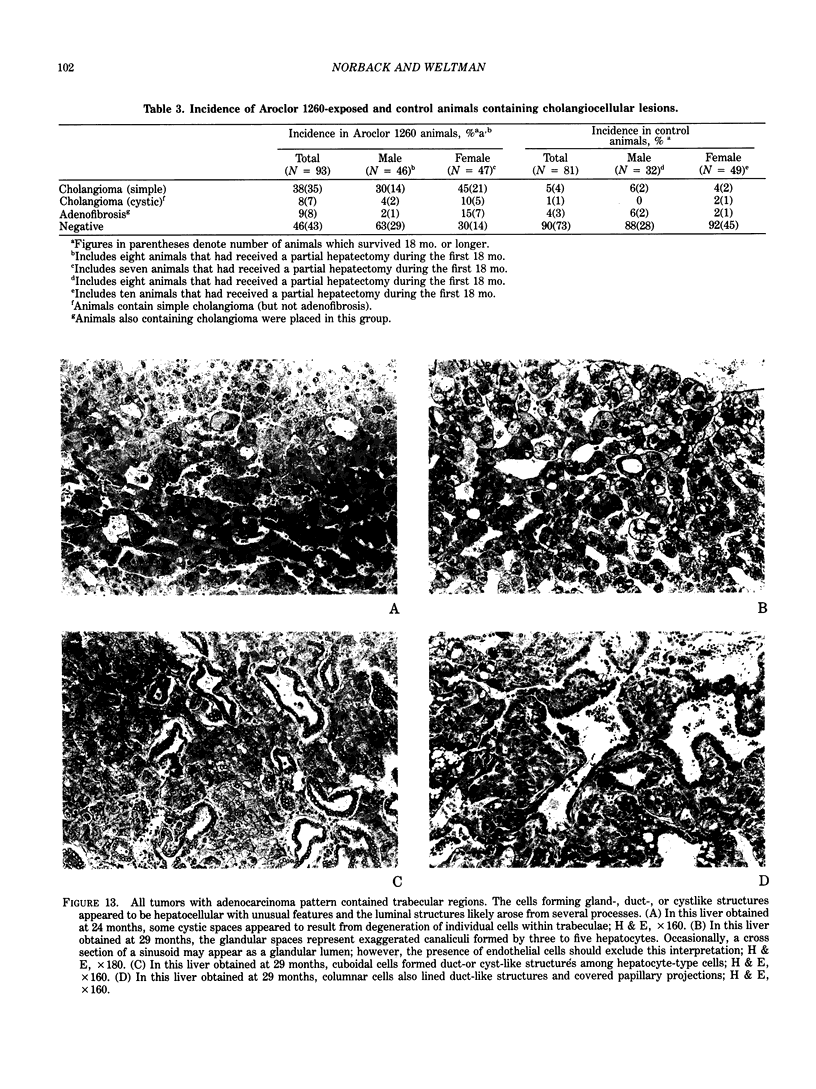
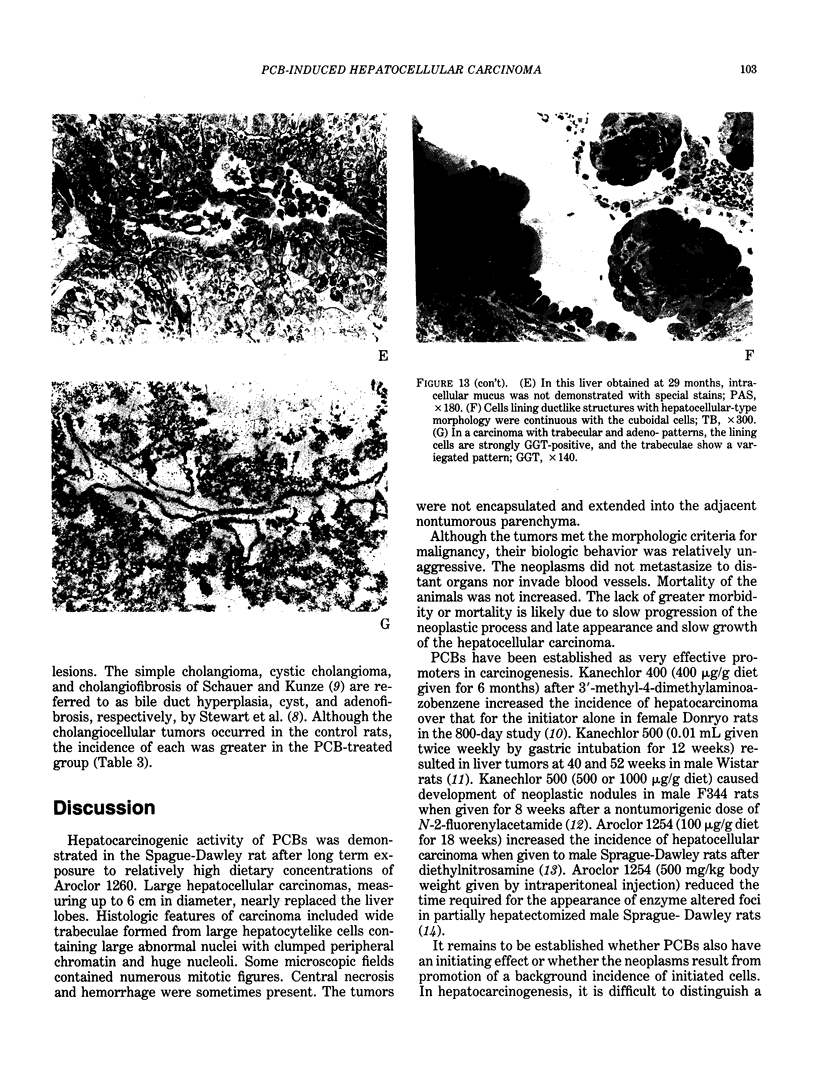


Images in this article
Selected References
These references are in PubMed. This may not be the complete list of references from this article.
- Booth J., Keysell G. R., Sims P. Effect of oestradiol on the in vitro metabolism of 7,12-dimethylbenz(a)anthracene and its hydroxymethyl derivatives. Biochem Pharmacol. 1974 Feb 1;23(3):735–744. doi: 10.1016/0006-2952(74)90638-8. [DOI] [PubMed] [Google Scholar]
- Gross L., Dreyfuss Y. Spontaneous tumors in Sprague-Dawley and Long-Evans rats and in their F1 hybrids: carcinogenic effect of total-body x-irradiation. Proc Natl Acad Sci U S A. 1979 Nov;76(11):5910–5913. doi: 10.1073/pnas.76.11.5910. [DOI] [PMC free article] [PubMed] [Google Scholar]
- Ito N., Nagasaki H., Makiura S., Arai M. Histopathological studies on liver tumorigenesis in rats treated with polychlorinated biphenyls. Gan. 1974 Dec;65(6):545–549. [PubMed] [Google Scholar]
- Kimbrough R. D., Linder R. E., Gaines T. B. Morphological changes in livers of rats fed polychlorinated biphenyls: light microscopy and ultrastructure. Arch Environ Health. 1972 Nov;25(5):354–364. doi: 10.1080/00039896.1972.10666186. [DOI] [PubMed] [Google Scholar]
- Kimbrough R. D., Squire R. A., Linder R. E., Strandberg J. D., Montalli R. J., Burse V. W. Induction of liver tumor in Sherman strain female rats by polychlorinated biphenyl aroclor 1260. J Natl Cancer Inst. 1975 Dec;55(6):1453–1459. doi: 10.1093/jnci/55.6.1453. [DOI] [PubMed] [Google Scholar]
- Kimura N. T., Baba T. Neoplastic changes in the rat liver induced by polychlorinated biphenyl. Gan. 1973 Feb;64(1):105–108. [PubMed] [Google Scholar]
- Kimura N. T., Kanematsu T., Baba T. Polychlorinated biphenyl(s) as a promotor in experimental hepatocarcinogenesis in rats. Z Krebsforsch Klin Onkol Cancer Res Clin Oncol. 1976 Dec 9;87(3):257–266. doi: 10.1007/BF00506498. [DOI] [PubMed] [Google Scholar]
- McCann J., Ames B. N. Detection of carcinogens as mutagens in the Salmonella/microsome test: assay of 300 chemicals: discussion. Proc Natl Acad Sci U S A. 1976 Mar;73(3):950–954. doi: 10.1073/pnas.73.3.950. [DOI] [PMC free article] [PubMed] [Google Scholar]
- Miller J. A. Carcinogenesis by chemicals: an overview--G. H. A. Clowes memorial lecture. Cancer Res. 1970 Mar;30(3):559–576. [PubMed] [Google Scholar]
- Nebert D. W., Bausserman L. L., Bates R. R. Effect of 17-beta-estradiol and testosterone on aryl hydrocarbon hydroxylase activity in mouse tissues in vivo and in cell culture. Int J Cancer. 1970 Nov 15;6(3):470–480. doi: 10.1002/ijc.2910060318. [DOI] [PubMed] [Google Scholar]
- Nishizumi M. Effect of phenobarbital, dichlorodiphenyltrichloroethane, and polychlorinated biphenyls on diethylnitrosamine-induced hepatocarcinogenesis. Gan. 1979 Dec;70(6):835–837. [PubMed] [Google Scholar]
- Norback D. H., Seymour J. L., Knieriem K. M., Peterson R. E., Allen J. R. Biliary metabolites of 2,5,2',5'-tetrachlorobiphenyl in the rat. Res Commun Chem Pathol Pharmacol. 1976 Jul;14(3):527–533. [PubMed] [Google Scholar]
- Pereira M. A., Herren S. L., Britt A. L., Khoury M. M. Promotion by polychlorinated biphenyls of enzyme-altered foci in rat liver. Cancer Lett. 1982 Feb;15(2):185–190. doi: 10.1016/0304-3835(82)90050-7. [DOI] [PubMed] [Google Scholar]
- Pitot H. C., Sirica A. E. The stages of initiation and promotion in hepatocarcinogenesis. Biochim Biophys Acta. 1980 May 6;605(2):191–215. doi: 10.1016/0304-419x(80)90004-9. [DOI] [PubMed] [Google Scholar]
- Preston B. D., Van Miller J. P., Moore R. W., Allen J. R. Promoting effects of polychlorinated biphenyls (Aroclor 1254) and polychlorinated dibenzofuran-free Aroclor 1254 on diethylnitrosamine-induced tumorigenesis in the rat. J Natl Cancer Inst. 1981 Mar;66(3):509–515. [PubMed] [Google Scholar]
- Rutenburg A. M., Kim H., Fischbein J. W., Hanker J. S., Wasserkrug H. L., Seligman A. M. Histochemical and ultrastructural demonstration of gamma-glutamyl transpeptidase activity. J Histochem Cytochem. 1969 Aug;17(8):517–526. doi: 10.1177/17.8.517. [DOI] [PubMed] [Google Scholar]
- Tatematsu M., Nakanishi K., Murasaki G., Miyata Y., Hirose M., Ito N. Enhancing effect of inducers of liver microsomal enzymes on induction of hyperplastic liver nodules by N-2-fluorenylacetamide in rats. J Natl Cancer Inst. 1979 Dec;63(6):1411–1416. [PubMed] [Google Scholar]
- Terao K., Nakano M. Cholangiofibrosis induced by short-term feeding of 3'-methyl-4-(dimethylamino)azobenzene: an electron microscopic observation. Gan. 1974 Jun;65(3):249–260. [PubMed] [Google Scholar]



